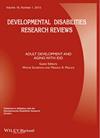Sandra J. Kelly, Charles R. Goodlett, John H. Hannigan
{"title":"Animal models of fetal alcohol spectrum disorders: Impact of the social environment","authors":"Sandra J. Kelly, Charles R. Goodlett, John H. Hannigan","doi":"10.1002/ddrr.69","DOIUrl":null,"url":null,"abstract":"<p>Animal models of fetal alcohol spectrum disorder (FASD) have been used to demonstrate the specificity of alcohol's teratogenic effects and some of the underlying changes in the central nervous system (CNS) and, more recently, to explore ways to ameliorate the effects of alcohol. The main point of this review is to highlight research findings from the animal literature which point to the impact of the social context or social behavior on the effect(s) of alcohol exposure during development, and also to point to research questions about the social environment and effects of prenatal alcohol exposure that remain to be answered. Alcohol exposure during early development alters maternal responding to the exposed pup in a variety of ways and the alteration in maternal responding could alter later stress responsivity and adult maternal and social behavior of the exposed offspring. Environmental enrichment and voluntary exercise have been shown to ameliorate some of alcohol's impact during development, but the roles of enhanced social interactions in the case of enrichment and of social housing during voluntary exercise need to be more fully delineated. Similarly, the role of social context across the lifespan, such as social housing, social experiences, and contact with siblings, needs further study. Because of findings that alcohol during development alters DNA methylation patterns and that there are alterations in the maternal care of the alcohol-exposed offspring, epigenetic effects and their relationship to social behavior in animal models of FASD are likely to become a fruitful area of research. Because of the simpler social behavior and the short lifespan of rodents, animal models of FASD can be useful in determining how the social context impacts the effects of alcohol exposure during development. © 2009 Wiley-Liss, Inc. Dev Disabil Res Rev 2009;15:200–208.</p>","PeriodicalId":55176,"journal":{"name":"Developmental Disabilities Research Reviews","volume":"15 3","pages":"200-208"},"PeriodicalIF":0.0000,"publicationDate":"2009-09-03","publicationTypes":"Journal Article","fieldsOfStudy":null,"isOpenAccess":false,"openAccessPdf":"https://sci-hub-pdf.com/10.1002/ddrr.69","citationCount":"86","resultStr":null,"platform":"Semanticscholar","paperid":null,"PeriodicalName":"Developmental Disabilities Research Reviews","FirstCategoryId":"1085","ListUrlMain":"https://onlinelibrary.wiley.com/doi/10.1002/ddrr.69","RegionNum":0,"RegionCategory":null,"ArticlePicture":[],"TitleCN":null,"AbstractTextCN":null,"PMCID":null,"EPubDate":"","PubModel":"","JCR":"","JCRName":"","Score":null,"Total":0}
引用次数: 86
Abstract
Animal models of fetal alcohol spectrum disorder (FASD) have been used to demonstrate the specificity of alcohol's teratogenic effects and some of the underlying changes in the central nervous system (CNS) and, more recently, to explore ways to ameliorate the effects of alcohol. The main point of this review is to highlight research findings from the animal literature which point to the impact of the social context or social behavior on the effect(s) of alcohol exposure during development, and also to point to research questions about the social environment and effects of prenatal alcohol exposure that remain to be answered. Alcohol exposure during early development alters maternal responding to the exposed pup in a variety of ways and the alteration in maternal responding could alter later stress responsivity and adult maternal and social behavior of the exposed offspring. Environmental enrichment and voluntary exercise have been shown to ameliorate some of alcohol's impact during development, but the roles of enhanced social interactions in the case of enrichment and of social housing during voluntary exercise need to be more fully delineated. Similarly, the role of social context across the lifespan, such as social housing, social experiences, and contact with siblings, needs further study. Because of findings that alcohol during development alters DNA methylation patterns and that there are alterations in the maternal care of the alcohol-exposed offspring, epigenetic effects and their relationship to social behavior in animal models of FASD are likely to become a fruitful area of research. Because of the simpler social behavior and the short lifespan of rodents, animal models of FASD can be useful in determining how the social context impacts the effects of alcohol exposure during development. © 2009 Wiley-Liss, Inc. Dev Disabil Res Rev 2009;15:200–208.
胎儿酒精谱系障碍的动物模型:社会环境的影响
胎儿酒精谱系障碍(FASD)的动物模型已被用于证明酒精致畸作用的特异性和中枢神经系统(CNS)的一些潜在变化,最近,还用于探索改善酒精影响的方法。这篇综述的主要观点是强调来自动物文献的研究发现,这些发现指出了社会背景或社会行为对发育期间酒精暴露影响的影响,也指出了关于社会环境和产前酒精暴露影响的研究问题仍有待回答。发育早期的酒精暴露会以多种方式改变母鼠对暴露幼崽的反应,而母鼠反应的改变可能会改变暴露幼崽后来的应激反应以及成年母性和社会行为。环境充实和自愿锻炼已被证明可以减轻酒精在发展过程中的一些影响,但在充实的情况下加强社会互动的作用和自愿锻炼期间社会住房的作用需要更充分地描述。同样,社会环境在整个生命周期中的作用,如社会住房、社会经历和与兄弟姐妹的接触,需要进一步研究。由于发现发育过程中的酒精会改变DNA甲基化模式,并且暴露于酒精的后代的母性护理也会发生变化,因此表观遗传效应及其与FASD动物模型中社会行为的关系可能成为一个富有成果的研究领域。由于啮齿动物的社会行为更简单,寿命更短,因此FASD的动物模型可以用于确定社会环境如何影响发育过程中酒精暴露的影响。©2009 Wiley-Liss, Inc。发展与残疾,2009;15:200-208。
本文章由计算机程序翻译,如有差异,请以英文原文为准。

 求助内容:
求助内容: 应助结果提醒方式:
应助结果提醒方式:


